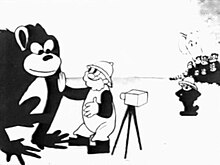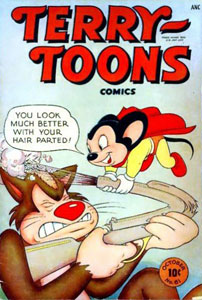Terrytoons
This article needs additional citations for verification. (June 2010) |
| Industry | Animation |
|---|---|
| Founded | 1929 |
| Founder | Unknown Frank Moser Paul Terry |
| Defunct | 1968 |
| Headquarters | "K" Building, New Rochelle, New York, United States |
Key people | Paul Houlton Terry |
| Parent | CBS Corporation |
Terrytoons was a studio in New Rochelle, New York, that produced animated cartoons for theatrical release from 1930 - 1971. Terrytoons was founded by Paul Terry and operated out of the "K" Building in downtown New Rochelle. The studio created many cartoon characters including Heckle and Jeckle, Mighty Mouse, Gandy Goose, Sourpuss, Dinky Duck and Luno. The "New Terrytoons" period of the late 1950s through early 1970s produced such characters as Hector Heathcote, Hashimoto and Deputy Dawg as well as The Mighty Heroes. Adult animation pioneer Ralph Bakshi got his start as an animator, and eventually as a director, at Terrytoons.[1] Terrytoons were originally released to theaters by 20th Century Fox. The Terrytoons library was later purchased by the CBS Corporation.
History
Before Terrytoons

Terry first worked for Bray Studios in 1916, where he created the Farmer Al Falfa series. He would then make a Farmer Al Falfa short for Edison Pictures, called "Farmer Al Falfa's Wayward Pup" (1917), and some later cartoons were made for Paramount Pictures.
Around 1921, Terry founded the Fables animation studio, named for its Aesop's Film Fables series, in conjunction with the studio of Amadee J. Van Beuren. Fables churned out a Fable cartoon every week for eight years in the 1920s. In 1928, Van Beuren, anxious to compete with the new phenomenon of talking pictures, released Terry's Dinner Time (released October 1928). Van Beuren then urged Terry to start producing actual sound films, instead of post-synchronizing the cartoons. Terry refused, and Van Beuren fired him in 1929. Almost immediately, Terry and much of his staff started up the Terrytoons studio. One staff member during that time was Art Babbitt, who went on to become a well known Disney animator.
Peak era
Through much of its history, the studio was considered one of the lowest-quality houses in the field, to the point where Paul Terry noted, "Disney is the Tiffany's in this business, and I am the Woolworth's." Terry's studio had the lowest budgets and was among the slowest to adapt to new technologies such as sound (in about 1930) and Technicolor (in 1938), while its graphic style remained remarkably static for decades. Background music was entrusted to one man, Philip Scheib, and Terry's refusal to pay royalties for popular songs forced Scheib to compose his own scores. Paul Terry took pride in producing a new cartoon every other week, regardless of the quality of the films. Following the success of Disney's Snow White and the Seven Dwarfs (1937) Paul Terry considered making an animated feature film adaptation of King Lear starring Farmer Al Falfa. However, after seeing the commercial failures of Disney's Pinocchio and Fantasia (both 1940) and Max Fleischer's Mr. Bug Goes to Town (1941), he decided to abandon the project. Until 1957, screen credits were very sparse, listing only the writer (until 1950, solely John Foster; then Tom Morrison thereafter), director (Terry's three main directors were Connie Rasinski, Eddie Donnelly and Mannie Davis), and musician (musical director Philip A. Scheib).
Terrytoons' first distributor was Educational Pictures, specialists in short-subject comedies and novelties. Audio-Cinema in the early 1930s backed the production of Terrytoons and distributed the Educational library internationally, except in the United Kingdom and Ireland, where the library was distributed by Educational and Gaumont British in partnership with the Ideal Film Company. The Fox Film company (from 1935, 20th Century-Fox) then released Educational shorts to theaters in the 1930s, giving the Terry cartoons wide exposure. After 20th Century-Fox withdrew its support from Educational Pictures, the company both backed and distributed Terrytoons. Farmer Al Falfa was Terry's most familiar character in the 1930s; Kiko the Kangaroo was spun off the Farmer Al Falfa series. Most of the other cartoons featured generic animal characters. One of the stock designs was a scruffy dog with a black patch around one eye; Terry ultimately built a series around this character, now known as Puddy the Pup.
Paul Terry may have realized that Educational was in financial trouble, because he found another lucrative outlet for his product. In 1938 he arranged to release his older cartoons through home-movie distributor Castle Films. Educational went out of business within the year, but 20th Century-Fox continued to release Terrytoons to theaters for the next two decades. With a new emphasis on "star" characters, Terrytoons featured the adventures of Super Mouse (later renamed Mighty Mouse), the talking magpies Heckle and Jeckle, silly Gandy Goose, Dinky Duck, mischievous mouse Little Roquefort, and The Terry Bears.
Despite the artistic drawbacks imposed by Terry's inflexible business policies, Terrytoons was nominated four times for the Academy Award for Animated Short Film: All Out for V in 1942, My Boy, Johnny in 1944, Mighty Mouse in Gypsy Life in 1945, and Sidney's Family Tree in 1958.
Changing hands
The studio was sold outright by the retiring Paul Terry to CBS in 1955, but 20th Century Fox (TCF) continued to distribute the studio's releases. It became a division of the CBS Films subsidiary. The following year, CBS put it under the management of UPA alumnus Gene Deitch, who had to work with even lower budgets.
Deitch's most notable works at the studio were the Tom Terrific cartoon segments for the Captain Kangaroo television show. He also introduced a number of new characters, such as Sidney the Elephant,[2] Gaston Le Crayon,[3] John Doormat,[citation needed] and Clint Clobber.[4]
After Deitch was fired in 1958, Bill Weiss took control of the studio. Under his supervision, Heckle and Jeckle and Mighty Mouse went back into production. Besides the three core directors of the Terry era who were still involved as animators and directors, two Famous Studios stalwarts joined the crew, Dave Tendlar and Martin Taras. Other new theatrical cartoon series included Hector Heathcote, Luno and Hashimoto San. In addition, the studio began producing the Deputy Dawg series for television in 1960. Another television production for the Captain Kangaroo show was The Adventures of Lariat Sam, which was written in part by Gene Wood, who would later become the announcer for several TV game shows including Family Feud.
Phil Scheib continued as the studio's musical director through the mid-1960s when he was replaced by Jim Timmens and Elliott Lawrence.
The best-known talent at Terrytoons in the 1960s was animator/director/producer Ralph Bakshi, who started with Terrytoons in the 1950s as an opaquer,[5] and eventually helmed the Mighty Heroes series. Bakshi left Terrytoons in 1967 for Paramount, which closed its cartoon unit later that year. He would later go on to produce Mighty Mouse: The New Adventures for television in 1987.
Post-history
After the departure of Bakshi, the studio petered out and finally closed in 1968. However, the film library was still regularly re-released to theatres by Fox, thus ensuring its existing cartoon library a long life in TV reruns. Its last short was an unsold TV pilot called Sally Sargent, about a 16-year-old girl who is a secret agent.
The Terrytoons cartoons (especially Mighty Mouse and Deputy Dawg) were syndicated to many local TV markets, and they were a staple of after-school and Saturday morning cartoon shows for over three decades, from the 1950s through the 1980s, until the television rights to the library were acquired by USA Network in 1989.
In the late '70s, Filmation Studios licensed the rights in order to make a new Mighty Mouse series. Later in 1987, Ralph Bakshi produced Mighty Mouse: The New Adventures which lasted for two seasons. Bakshi and John Kricfalusi inspired the staff to try to get as much Jim Tyer-style drawing in the show as possible. Tyer, a stand-out Terry animator of the original cartoons with a unique style, became a strong influence on the artists of the Bakshi series.
In 2002, the Terrytoons characters returned to television in original commercials for Brazilian blue cheese (for what is now America's Dairy Farmers) and a fine wine.
Through the years that have followed since the last Terrytoons TV series material in 1988, the rights have been scattered as result of prior rights issues and corporate changes involving Viacom, which had absorbed CBS Films (the ownership and distribution history is noted below). However, some Terrytoons shorts are believed to be in the public domain, and have been issued on low-budget VHS tapes and DVDs. The first official release of any Terrytoons material by CBS DVD has been announced (Mighty Mouse: The New Adventures was issued January 5, 2010).
Licensing and merchandising

Among the many licensed Terrytoons products are comic books, with the company's characters initially licensed to Timely Comics, a predecessor of Marvel Comics, in the early 1940s. Later, St. John Publications took over the licensing, publishing comics featuring such characters as Mighty Mouse, the magpies Heckle and Jeckle, Gandy Goose, and Little Roquefort. The first such St. John comic was Mighty Mouse #5 (Aug. 1947), its numbering taken over from the Timely run. St. John's Terrytoons comics include the field's first 3-D comic book, Three Dimension Comics #1 (Sept. 1953 oversize format, Oct. 1953 standard-size reprint), featuring Mighty Mouse.[6] According to Joe Kubert, co-creator with the brothers Norman Maurer and Leonard Maurer, it sold an exceptional 1.2 million copies at 25 cents apiece[7] at a time when comics cost a dime.
Ownership
- Independent (1930–1955, as company);
- Columbia Broadcasting System, Inc. (1955–1971, as company and underlying rights to library);
- Viacom (1971–2006, underlying rights to library);
- CBS Corporation (2006–present, underlying rights to library).
Distribution
- Educational Pictures (1930 until 1936)
- 20th Century Fox (1936 until 1971; and theatrical re-distribution rights until 1994)
- Paramount Pictures (re-distribution theatrical rights, 1994–2006; and from 2006 forward, only on behalf of CBS)
- Paramount Home Media Distribution (home video and DVD rights, only on behalf of CBS Home Entertainment)
- CBS Television Studios (television rights, only on behalf of CBS Television Distribution)
Productions
See List of Terrytoons animated shorts. for complete filmography
Cartoon series
|
|
TV series
- Barker Bill´s Cartoon Show
- Mighty Mouse Playhouse
- The Heckle and Jeckle Show
- Tom Terrific
- The Deputy Dawg Show
- The Hector Heathcote Show
- The Adventures of Lariat Sam
- The Astronut Show
- Mighty Mouse & The Mighty Heroes
One-shots
See also: List of one-shots Terrytoons animated shorts
References
- ^ Maltin, Leonard (1987). Of Mice and Magic: A history of American animated cartoons (Rev. ed.). New York: New American Library.
- ^ Sidney the Elephant at Don Markstein's Toonopedia. Archived from the original on January 20, 2015.
- ^ Gaston Le Crayon at Don Markstein's Toonopedia. Archived from the original on April 16, 2012.
- ^ Clint Clobber at Don Markstein's Toonopedia. Archived from the original on April 16, 2012.
- ^ Maltin, L. (1987). Of mice and magic: A history of American animated cartoons (Rev. ed.). New York: New American Library.
- ^ Zone, Ray (n.d.). "1950s 3-D Comic Book Checklist". Ray3DZone.com. Archived from the original on February 11, 2009.
{{cite web}}: Unknown parameter|deadurl=ignored (|url-status=suggested) (help) - ^ Joe Kubert interview, "A Myth in the World of Comics", UniversoHQ.com, n.d. WebCitation archive.
- ^ Little Roquefort at Don Markstein's Toonopedia. Archived from the original on November 16, 2015.
